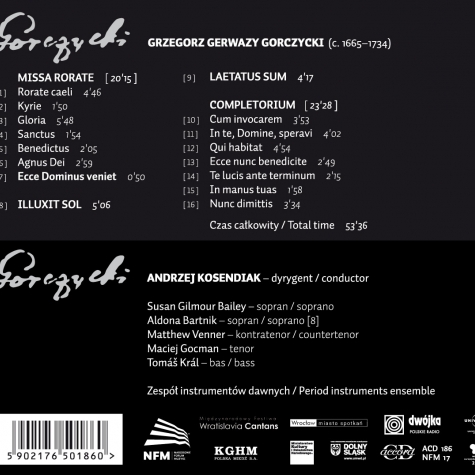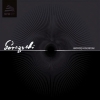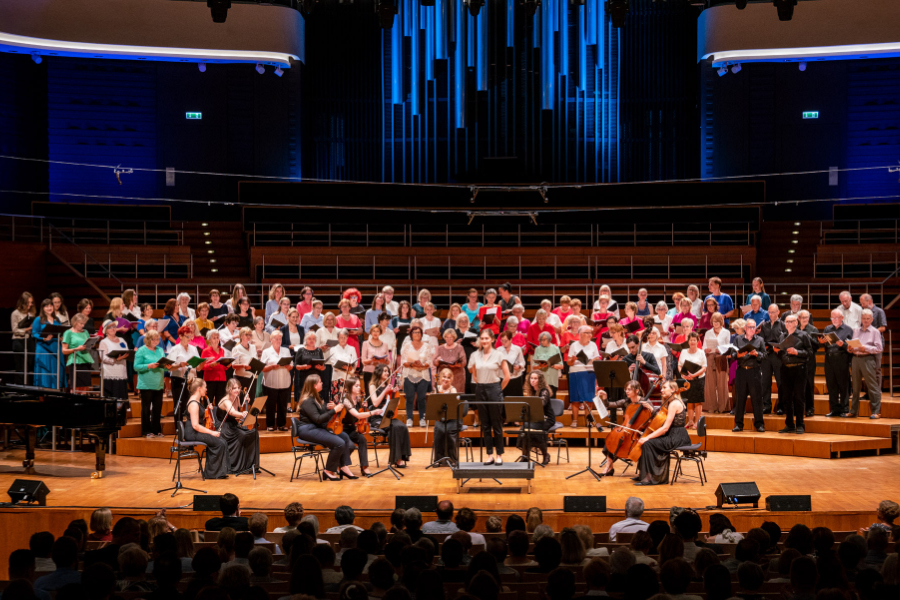Gorczycki I
The debut album of the Wrocław Baroque Ensemble conducted by Andrzej Kosendiak and the first part of the Music First series. It is a series of CDs with works by Polish composers of the 17th and 18th centuries performed by the Wrocław Baroque Ensemble and the Wrocław Baroque Orchestra conducted by Andrzej Kosendiak, published by the National Forum of Music and CD Accord since 2012. Just a dozen or so years ago, many of the pieces presented on these albums were unknown. The works are performed in the arrangements in which they were or could have been played centuries ago. The high value of the series is evidenced by the elegant and consistent graphic design and the bilingual essays included in the booklets attached to the discs, written by researchers specialising in the work of the featured composers. The releases also contain original vocal texts and their translations into Polish and English.
Album premiere: 2012
Publishers: National Forum of Music, CD Accord
Conductor: Andrzej Kosendiak
Performers: Wrocław Baroque Ensemble
I have had many opportunities of performing Gorczycki’s works, which have strengthened my conviction about this composer’s exceptional art. The featured recording constitutes, as it were, a sum total of these experiences. Hence the necessity to include stylistically diverse works, whose variety is a characteristic quality of the composer’s entire contribution. Alongside works in concertante style, the recording also features Missa Rorate written in an early polyphonic style.
Andrzej Kosendiak
Grzegorz Gerwazy Gorczycki, arguably the most eminent Polish composer of the late Baroque, is a figure distinguished from others of the period not only by his compositional attributes but also by a relatively large amount of surviving works and a widely recognized biography. A Silesian, he was born in 1665 in Rozbark near Bytom and died on 30 April 1734 in Kraków. Attention is drawn to the high level of his education: he studied liberal arts and philosophy in Prague and theology in Vienna, where no doubt he acquired his musical knowledge and skills. He came to Kraków no later than 1690, where he took holy orders and remained for the rest of his life, apart from two years spent in Chełmno as teacher at the Academy and leader of the Chapel at the Archpresbyterial Church. During this period, he may also have made a trip to Rome. He held various functions and high offices in the Church and was remembered by the clergy and faithful as a dedicated priest and a paragon of Christian virtues, which sentiments remain etched on the memorial plaque, which survives to this day in the Wawel Chapel. Historically however he is remembered above all as an outstanding musician and composer, who held the post of Magister capellae continuously from 1698 until his death. In 1702 he was also appointed to the College of so-called Angelists, whose figural singing added splendour to the liturgy celebrated at the St Stanislaus cathedral.
Gorczycki’s surviving contribution includes 50 compositions of established authorship and 32 attributed to him. They consist almost exclusively of polyphonic settings of sacred Latin texts, composed in various genres and styles for the needs of Wawel Cathedral’s rich liturgy. The composer’s output comprises vocal works reaching back to the a cappella style of the Renaissance (motets, hymns, masses), vocal-instrumental compositions in the concertante style of the Baroque (vocal concertos) and a group of chorale cantatas (mainly hymns) supported by instrumental accompaniment in the vocal parts. Gorczycki composed primarily for the ensemble he led, yet some of his vocal works could have been intended for the earlier mentioned College of Angelists or the Capella Rorantistarum associated with the King Sigismund Chapel. Furthermore, the Wawel Kapellmeister’s contributions were appreciated not only within his Kraków milieu, as his works also found their way into the repertoires of other Church ensembles (e.g. the featured Completorium comes from an extant copy held in the archive of the church in Raków Opatowski, while Laetatus sum – from the Benedictine Order in Sandomierz; he was also known in Wieluń and the Spisz region).
The works of Grzegorz Gerwazy Gorczycki are today recognized both as valuable records of early Polish music and above all as compositions of great aesthetic value. They constitute a concert repertoire yet fulfil a somewhat different function than during the composer’s times. Musicians, reaching today for the works of the Wawel Kapellmeister written three centuries ago, search for specific interpretive means of attaining an optimal sound and extracting fully the artistic qualities of his music. A perfect outcome of such research is the performance of works featured in this recording.
Elżbieta Zwolińska
Awards: Nomination for Fryderyk 2013, Wrocław Music Prize 2013












